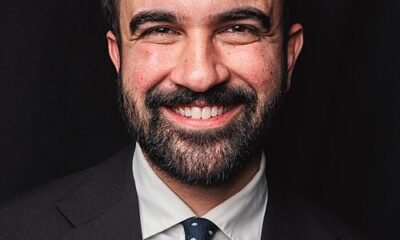Business
Supreme Court signals it will claw back federal agency power on January 17, 2024 at 7:26 pm Business News | The Hill
The Supreme Court’s conservatives appeared inclined to cut back the regulatory power of federal agencies, with at least several justices during a pair of arguments Wednesday seeming ready to overrule a legal doctrine that has bolstered agencies’ authority for decades.
Over more than three hours of argument, the justices put the Biden administration’s top Supreme Court lawyer on defense as she sought to preserve Chevron deference, which instructs courts to defer to agencies’ interpretation of federal law if it could have multiple meanings.
The practice has strengthened presidential administrations’ ability to regulate wide aspects of daily life. The range of examples referenced at the arguments revealed the breadth of Chevron’s impact: artificial intelligence, cryptocurrency, environmental protections and more.
A majority of justices appeared sympathetic to the conservative lawyers who urged them to outright overrule the precedent or at least narrow its scope, which would mark a major legal victory for business and anti-regulatory interests.
In particular, three members of the high court’s conservative wing — Justices Clarence Thomas, Neil Gorsuch and Brett Kavanaugh — reiterated their long-publicized concerns about the precedent’s viability.
“The government always wins,” Gorsuch said.
Critics contend that Chevron requires judges to abdicate their responsibility to interpret the law. They also note a lack of consensus on when a statute is ambiguous enough to trigger deference to an agency and how some federal judges have openly criticized the doctrine.
“Should that be a clue that something needs to be fixed here?” Gorsuch said.
The court’s three liberal justices, Sonia Sotomayor, Elena Kagan and Ketanji Brown Jackson, meanwhile, expressed opposition to overturning Chevron. They emphasized a desire to defer to subject-matter experts at agencies when ambiguous, complicated policy issues arise, rather than having a judge attempt to draw the line.
“My concern is that if we take away something like Chevron, the court will then suddenly become a policymaker,” said Jackson.
Kagan gave a hypothetical about whether a judge or the Department of Health and Human Services should be the one to decide whether a cholesterol reducer should be considered a “drug” or a “dietary supplement.”
“In that case I would rather have people at HHS telling me whether this new product was a dietary supplement or a drug,” she said.
Kagan added at one point, “Judges should know what they don’t know.”
The liberals also questioned whether overturning Chevron would unleash a flood of litigation, as people who lost cases because of the doctrine would seek to have their issues reheard.
Conservative Justice Amy Coney Barrett, who posed fierce questions to both sides, also raised concerns about a shock to the system.
The lawyers attempting to overturn Chevron pushed back on the notion, insisting that the thousands of decisions that have invoked the doctrine over the past four decades would still be considered precedent and subject to strong protection.
And some conservative justices argued the opposite, contending that it is Chevron that has created shocks by giving the executive branch a wide license to flip-flop on its interpretations of statutes to fit its policy goals.
“The reality of how this works is Chevron itself has shocks to the system when a new administration comes in,” Kavanaugh said.
Meanwhile, Chief Justice John Roberts, who has been reluctant to overrule the court’s precedents, questioned whether the doctrine had already been overruled in practice. The Supreme Court has not invoked Chevron since 2016, and in some recent cases, the justices have either enacted carveouts or simply ignored the precedent.
“How much of an actual question on the ground is this?” Roberts asked.
The justices weighed whether to replace Chevron with another, more narrow test known as Skidmore, under which a judge would decide to defer to an agency only if the agency’s argument is persuasive. As part of that analysis, judges examine consistency or whether an agency has flip-flopped.
Kavanaugh characterized Skidmore as being about “the power to persuade not the power to control.”
The high court on Wednesday considered the weighty dispute through two separate cases that are near-identical.
In both, herring fishermen are challenging a rule mandating their companies fund federal monitors on-board their vessels. Invoking Chevron, lower courts deferred to the agency and upheld the rule.
Each group of plaintiffs had a veteran Supreme Court advocate arguing for them and is also backed by an anti-regulatory group.
The justices first heard from Roman Martinez, a partner at Latham & Watkins, who is representing a Rhode Island-based fishing fleet alongside the conservative New Civil Liberties Alliance.
And in the second case, the plaintiffs are represented by the conservative Cause of Action Institute and Paul Clement, who served as former President George W. Bush’s top Supreme Court lawyer and has successfully argued cases that resulted in some of the biggest wins for conservatives at the high court in recent years.
Jackson is recusing herself from that case, as she had heard oral arguments in the dispute while sitting on a lower court.
Decisions in the cases, Loper Bright Enterprises v. Raimondo and Relentless, Inc. v. Department of Commerce, are expected by the end of June.
Court Battles, Business, News, Chevron doctrine, Supreme Court The Supreme Court’s conservatives appeared inclined to cut back the regulatory power of federal agencies, with at least several justices during a pair of arguments Wednesday seeming ready to overrule a legal doctrine that has bolstered agencies’ authority for decades. Over more than three hours of argument, the justices put the Biden administration’s top Supreme Court lawyer on…
Business
Harvard Grads Jobless? How AI & Ghost Jobs Broke Hiring

America’s job market is facing an unprecedented crisis—and nowhere is this more painfully obvious than at Harvard, the world’s gold standard for elite education. A stunning 25% of Harvard’s MBA class of 2025 remains unemployed months after graduation, the highest rate recorded in university history. The Ivy League dream has become a harsh wakeup call, and it’s sending shockwaves across the professional landscape.

Jobless at the Top: Why Graduates Can’t Find Work
For decades, a Harvard diploma was considered a golden ticket. Now, graduates send out hundreds of résumés, often from their parents’ homes, only to get ghosted or auto-rejected by machines. Only 30% of all 2025 graduates nationally have found full-time work in their field, and nearly half feel unprepared for the workforce. “Go to college, get a good job“—that promise is slipping away, even for the smartest and most driven.
Tech’s Iron Grip: ATS and AI Gatekeepers
Applicant tracking systems (ATS) and AI algorithms have become ruthless gatekeepers. If a résumé doesn’t perfectly match the keywords or formatting demanded by the bots, it never reaches human eyes. The age of human connection is gone—now, you’re just a data point to be sorted and discarded.
AI screening has gone beyond basic qualifications. New tools “read” for inferred personality and tone, rejecting candidates for reasons they never see. Worse, up to half of online job listings may be fake—created simply to collect résumés, pad company metrics, or fulfill compliance without ever intending to fill the role.
The Experience Trap: Entry-Level Jobs Require Years
It’s not just Harvard grads who are hurting. Entry-level roles demand years of experience, unpaid internships, and portfolios that resemble a seasoned professional, not a fresh graduate. A bachelor’s degree, once the key to entry, is now just the price of admission. Overqualified candidates compete for underpaid jobs, often just to survive.
One Harvard MBA described applying to 1,000 jobs with no results. Companies, inundated by applications, are now so selective that only those who precisely “game the system” have a shot. This has fundamentally flipped the hiring pyramid: enormous demand for experience, shrinking chances for new entrants, and a brutal gauntlet for anyone not perfectly groomed by internships and coaching.
Burnout Before Day One
The cost is more than financial—mental health and optimism are collapsing among the newest generation of workers. Many come out of elite programs and immediately end up in jobs that don’t require degrees, or take positions far below their qualifications just to pay the bills. There’s a sense of burnout before careers even begin, trapping talent in a cycle of exhaustion, frustration, and disillusionment.
Cultural Collapse: From Relationships to Algorithms
What’s really broken? The culture of hiring itself. Companies have traded trust, mentorship, and relationships for metrics, optimizations, and cost-cutting. Managers no longer hire on potential—they rely on machines, rankings, and personality tests that filter out individuality and reward those who play the algorithmic game best.
AI has automated the very entry-level work that used to build careers—research, drafting, and analysis—and erased the first rung of the professional ladder for thousands of new graduates. The result is a workforce filled with people who know how to pass tests, not necessarily solve problems or drive innovation.
The Ghost Job Phenomenon
Up to half of all listings for entry-level jobs may be “ghost jobs”—positions posted online for optics, compliance, or future needs, but never intended for real hiring. This means millions of job seekers spend hours on applications destined for digital purgatory, further fueling exhaustion and cynicism.
Not Lazy—Just Locked Out
Despite the headlines, the new class of unemployed graduates is not lazy or entitled—they are overqualified, underleveraged, and battered by a broken process. Harvard’s brand means less to AI and ATS systems than the right keyword or résumé format. Human judgment has been sidelined; individuality is filtered out.

What’s Next? Back to Human Connection
Unless companies rediscover the value of human potential, mentorship, and relationships, the job search will remain a brutal numbers game—one that even the “best and brightest” struggle to win. The current system doesn’t just hurt workers—it holds companies back from hiring bold, creative talent who don’t fit perfect digital boxes.
Key Facts:
- 25% of Harvard MBAs unemployed, highest on record
- Only 30% of 2025 grads nationwide have jobs in their field
- Nearly half of grads feel unprepared for real work
- Up to 50% of entry-level listings are “ghost jobs”
- AI and ATS have replaced human judgment at most companies
If you’ve felt this struggle—or see it happening around you—share your story in the comments. And make sure to subscribe for more deep dives on the reality of today’s economy and job market.
This is not just a Harvard problem. It’s a sign that America’s job engine is running on empty, and it’s time to reboot—before another generation is locked out.
Business
Why 9 Million Americans Have Left

The Growing American Exodus
Nearly 9 million Americans now live outside the United States—a number that rivals the population of several states and signals a profound shift in how people view the American dream. This mass migration isn’t confined to retirees or the wealthy. Thanks to remote work, digital nomad visas, and mounting pressures at home, young professionals, families, and business owners are increasingly joining the ranks of expats.

Rising Costs and Shrinking Wallets
Living in the US has become increasingly expensive. Weekly grocery bills topping $300 are not uncommon, and everyday items like coffee and beef have surged in price over the last year. Rent, utilities, and other essentials also continue to climb, leaving many Americans to cut meals or put off purchases just to make ends meet. In contrast, life in countries like Mexico or Costa Rica often costs just 50–60% of what it does in the US—without sacrificing comfort or quality.
Health Care Concerns Drive Migration
America’s health care system is a major trigger for relocation. Despite the fact that the US spends more per person on health care than any other country, millions struggle to access affordable treatment. Over half of Americans admit to delaying medical care due to cost, with households earning below $40,000 seeing this rate jump to 63%. Many expats point to countries such as Spain or Thailand, where health care is both affordable and accessible, as a major draw.

Seeking Safety Abroad
Public safety issues—especially violent crime and gun-related incidents—have made many Americans feel unsafe, even in their own communities. The 2024 Global Peace Index documents a decline in North America’s safety ratings, while families in major cities often prioritize teaching their children to avoid gun violence over simple street safety. In many overseas destinations, newly arrived American families report a significant improvement in their sense of security and peace of mind.
Tax Burdens and Bureaucracy
US tax laws extend abroad, requiring expats to file annual returns and comply with complicated rules through acts such as FATCA. For some, the burden of global tax compliance is so great that thousands relinquish their US citizenship each year simply to escape the paperwork and scrutiny.
The Digital Nomad Revolution
Remote work has unlocked new pathways for Americans. Over a quarter of all paid workdays in the US are now fully remote, and more than 40 countries offer digital nomad visas for foreign professionals. Many Americans are leveraging this opportunity to maintain their US incomes while cutting costs and upgrading their quality of life abroad.

Conclusion: Redefining the Dream
The mass departure of nearly 9 million Americans reveals deep cracks in what was once considered the land of opportunity. Escalating costs, inaccessible healthcare, safety concerns, and relentless bureaucracy have spurred a global search for better options. For millions, the modern American dream is no longer tied to a white-picket fence, but found in newfound freedom beyond America’s borders.
Business
Will Theaters Crush Streaming in Hollywood’s Next Act?

Hollywood is bracing for a pivotal comeback, and for movie lovers, it’s the kind of shake-up that could redefine the very culture of cinema. With the freshly merged Paramount-Skydance shaking up its strategy, CEO David Ellison’s announcement doesn’t just signal a change—it reignites the passion for moviegoing that built the magic of Hollywood in the first place.

Theatrical Experience Roars Back
Fans and insiders alike have felt the itch for more event movies. For years, streaming promised endless options, but fragmented attention left many longing for communal spectacle. Now, with Paramount-Skydance tripling its film output for the big screen, it’s clear: studio leaders believe there’s no substitute for the lights, the hush before the opening credits, and the collective thrill of reacting to Hollywood’s latest blockbusters. Ellison’s pivot away from streaming exclusives taps deep into what unites cinephiles—the lived experience of cinema as art and event, not just content.
Industry Pulse: From Crisis to Renaissance
On the financial front, the numbers are as electrifying as any plot twist. After years of doubt, the box office is roaring. AMC, the world’s largest theater chain, reports a staggering 26% spike in moviegoer attendance and 36% revenue growth in Q2 2025. That kind of momentum hasn’t been seen since the heyday of summer tentpoles—and it’s not just about more tickets sold. AMC’s strategy—premium screens, with IMAX and Dolby Cinema, curated concessions, and branded collectibles—has turned every new release into an event, driving per-customer profits up nearly 50% compared to pre-pandemic norms.
Blockbusters Lead the Culture
Forget the gloom of endless streaming drops; when films like Top Gun: Maverick, Mission: Impossible, Minecraft, and surprise hits like Weapons and Freakier Friday draw crowds, the industry—and movie fans—sit up and take notice. Movie-themed collectibles and concession innovations, from Barbie’s iconic pink car popcorn holders to anniversary tie-ins, have made each screening a moment worth remembering, blending nostalgia and discovery. The focus: high-impact, shared audience experiences that streaming can’t replicate.
Streaming’s Limits and Studio Strategy
Yes, streaming is still surging, but the tide may be turning. The biggest franchises, and the biggest cultural events, happen when audiences come together for a theatrical release. Paramount-Skydance’s shift signals to rivals that premium storytelling and box office spectacle are again at the center of Hollywood value creation. The result is not just higher profits for exhibitors like AMC, but a rebirth of movie-going as the ultimate destination for fans hungry for connection and cinematic adventure.

Future Forecast: Culture, Community, and Blockbuster Dreams
As PwC and others warn that box office totals may take years to fully catch up, movie lovers and industry leaders alike are betting that exclusive theatrical runs, enhanced viewing experiences, and fan-driven engagement are the ingredients for long-term recovery—and a new golden age. The Paramount-Skydance play is more than a business move; it’s a rallying cry for the art of the theatrical event. Expect more big bets, more surprises, and—finally—a long-overdue renaissance for the silver screen.
For those who believe in the power of cinema, it’s a thrilling second act—and the best seat in the house might be front and center once again.

 News4 weeks ago
News4 weeks agoDiddy Wakes Up to Knife in Prison Attack

 Business4 weeks ago
Business4 weeks agoHarvard Grads Jobless? How AI & Ghost Jobs Broke Hiring

 Entertainment2 weeks ago
Entertainment2 weeks agoAfter Party: Festival Winner for Best Romantic Short

 News1 week ago
News1 week agoCamp Wackapoo – Rise of Glog Takes Center Stage

 Entertainment1 week ago
Entertainment1 week agoFrancisco Ramos Takes Top Mockumentary Award at Houston Comedy Film Festival

 Politics2 weeks ago
Politics2 weeks agoMamdani’s Victory Triggers Nationwide Concern Over New York’s Future

 Politics2 weeks ago
Politics2 weeks agoTrump’s $2,000 Tariff Dividend Plan: Who Gets Paid?

 News1 week ago
News1 week ago50-Year Mortgages: A Game Changer or a Debt Trap?





























